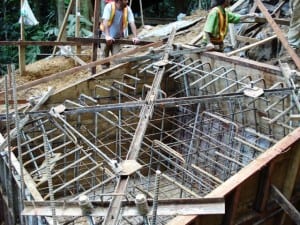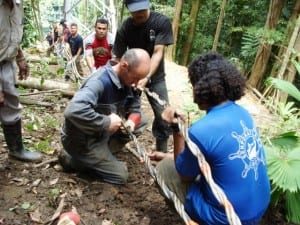Tripatini
the world's smartest travel social network
Veragua Aerial Tram Offers Glimpse into Hidden Rainforest
Suspended on cables gliding through the tops of giant tropical trees, amid hidden, dripping, hanging gardens full of plants and animals in the rainforest, is a pretty cool experience. Rainforest trees are tall, really tall, even towering up to more than 100 feet high. The microcosm of life happening at this level is abundant and amazing, and not often seen.
Unlike canopy zip line tours, which have become all about the thrill of zipping as fast as possible on long, high cables through the treetops, aerial tramways move slowly, silently and smoothly above and through the tree canopy. Passengers are rewarded with unique, unobstructed views of life far above the forest floor along with scenic panoramas that can be absorbed better than flying by at 30-40 mph.
Though the first aerial tram was built in 1644 in Europe to move soil to build defenses, aerial tramways began their popularity for sightseeing in the Alps in the 1920s, according to Wikipedia. Nowadays, there is a proliferation of aerial tramways in the Alpine regions of Europe. Flums, Switzerland, in the gorgeous “Heidiland” region of the Swiss Alps, is home to one of the world’s leading companies in cable railway systems, Bartholet Metallbau AG (BMF). With 200 employees and 50 years of experience, BMF is an expert in aerial tramways, ski lifts, gondolas, etc. They even built the world’s first solar-powered ski lift in the small ski destination of Tenna, Switzerland.
Did you ever wonder how an aerial tramway is built and works? It’s not easy. In Costa Rica, aerial tramways are built in thick jungle, and usually involve rugged mountains or canyons, or both. It was the Swiss technology of Bartholet Metallbau that brought to life Veragua Rainforest’s aerial tramway near the Caribbean Coast in Costa Rica. The Swiss company worked closely with Costa Rican engineers from the company Constructora Icon S.A., who built Veragua’s aerial tramway and the entire Research and Adventure Park.
Veragua Rainforest Research & Adventure is a 1,300 hectare (3,212 acre) biology research and adventure center, located about an hour inland from Costa Rica’s historic Caribbean port town of Limón. It is an area of breathtaking tropical rainforest in the foothills of the Talamanca Mountain Range bordering the La Amistad (“Friendship”) International Park, the country’s largest and most remote national park that is shared by both Costa Rica and Panama. Veragua contains walking trails through the rainforest, a river and waterfall, the aerial tramway, a canopy zip line tour, biology research station and wildlife habitats, along with a restaurant, café and souvenir shop.
Veragua Rainforest’s Aerial Tramway is the means of transportation connecting the upper section of the park, where the Welcome Center and wildlife habitats are located, down into the Victoria River Canyon for the walking trails to the river, waterfall, and through the primary rainforest. The terrain is steep and uneven through thick rainforest with huge trees and dense undergrowth.
Project Engineer Henry Fallas tells that the Veragua work crews had to build the aerial tramway all by hand due to the mountainous terrain, coupled with the task to preserve the forest as intact as possible. “This was a big challenge, but we managed it well,” Fallas said. “It was a big project for the area, being in such a remote location.”
There wasn’t even a road getting to the area where Veragua Rainforest is located, back in 2006 when the project began construction. Project Director Eduardo Estrada, also an engineer with Constructora Icon, and Fallas had their hands full organizing the road, electricity, water and the entire infrastructure for the adventure park. The upside is Veragua’s construction brought great improvements to the area’s rural community with new roads, a modern water system and improved electrical network.
Bartholet Metallbau sent from Switzerland the plans, design, engineering, technology and specific materials for the aerial tramway. Then the Costa Rican engineers had to apply Costa Rican regulations to nationalize the Civil Engineering plans, following Costa Rica’s seismic and engineering codes. Expert technician and Engineer Pablo Secul with the company ISB – Ingeniería de Montana came from Bariloche, Argentina to help with the installation. Secul’s company specializes in building, designing, inspections, maintenance and repairing projects having to do with elevation – aerial trams, ski lifts, gondolas, bridges, etc.
Crews of up to 40 workers toiled around the clock in the Caribbean’s heat and frequent rain building the concrete bases, towers, and upper and lower base stations for the aerial tramway. They rigged a system of temporary cables to employ an enormous metal “basket” to bring materials up and down between the tower areas. Personnel had to work at night to use the cables and winch to lower materials so that during the day the winch was available to work and to move tools, etc. Approximately 9,500 sacks of Concremix ready-mix concrete were moved down the mountain to build the enormous tower foundations. “It takes a lot of force and mechanics” to build an aerial tramway, said Fallas. “There is a lot of technology in the system.”
Over a 7-month period, the upper and lower base stations and five towers, ranging in height from 6 meters (20 ft.) to 14 meters (46 ft.) high, were erected. More than 429 meters (1,407 ft.) of thickly bound 36 mm (1.4 in.) steel cable spans a distance of 370 meters (1,214 ft.) at a 35-degree angle and a 200 meter (656 ft.) vertical elevation change.
“The most interesting aspect is when they joined the ends of the cable,” commented Fallas. A specific technician came all the way from Switzerland for the job. “There are very few persons in the world that can do this work,” Fallas explained. Many different steel strands are woven together to make one thick cable. The technician had to join together each strand of each end to make one whole cable that is just as strong as the rest.
The finished product results in two fixed open-air tram cars, each carrying 8 persons that travel up and down each side of the tramway, powered by its own generator-run electrical plant. Distinct from a continuously circulating gondola or ski lift system, aerial tramways are constructed as reversible systems; tram cars shuttle back and forth between two end terminals propelled by a cable loop which stops and reverses direction when the cars arrive at the end stations. They don’t circle around like a gondola or ski lift chairs.
Riding on Veragua’s aerial tramway, you’ll see colorful tropical wildlife and spectacular rainforest vegetation. Most animals live in the upper rainforest canopy where they feed on fruits and seeds that grow where the sunlight touches. Journeying into this amazing world that most people never see, you can observe monkeys, exotic birds, colorful insects, the occasional shy sloth, and other extraordinary rainforest inhabitants from the unhurried comfort of the open tram cars. Naturalist guides are on-board with you to explain what you’re seeing.
Veragua Rainforest Research & Adventure is a must-see attraction when visiting Costa Rica’s Caribbean area. Veragua Rainforest Research & Adventure is open Tuesday to Sunday, from 8:00 am to 3:00 pm. Admission is $66 for adults and $55 for children/students; children under age 4 receive free admission. The entrance price includes all activities and attractions, with the exception of the canopy tour – which is an additional fee. Veragua is located 40 minutes from Limon and 2 ½ hours from San José, in Brisas de Veragua, 12 km south from the Liverpool entrance on the highway to Limón.
Videos
Groups
-
India
173 members
-
Tour Operators
873 members
-
Ireland
93 members
-
South Dakota
17 members
-
Azerbaijan
17 members
-
Shopping the World
55 members
-
Tech for Travel/Hospital…
87 members
-
Andorra
26 members
-
Online Corner
75 members
-
Minnesota
22 members
-
Backpackers & Hostels
84 members
-
Portugal
60 members
-
Turks and Caicos
26 members
-
Agritourism/Farmstays
72 members
-
Zambia
21 members
© 2025 Created by EnLinea Media.
Powered by
![]()
Badges | Report an Issue | Privacy Policy | Terms of Service








You need to be a member of Tripatini to add comments!
Join Tripatini